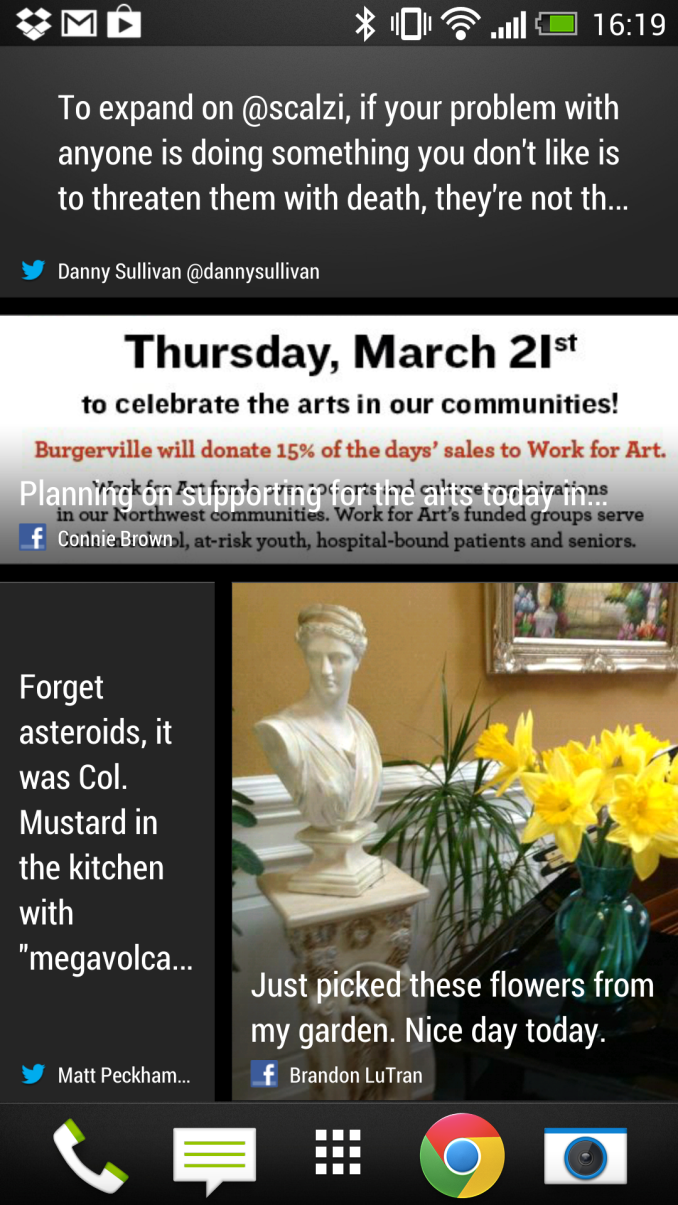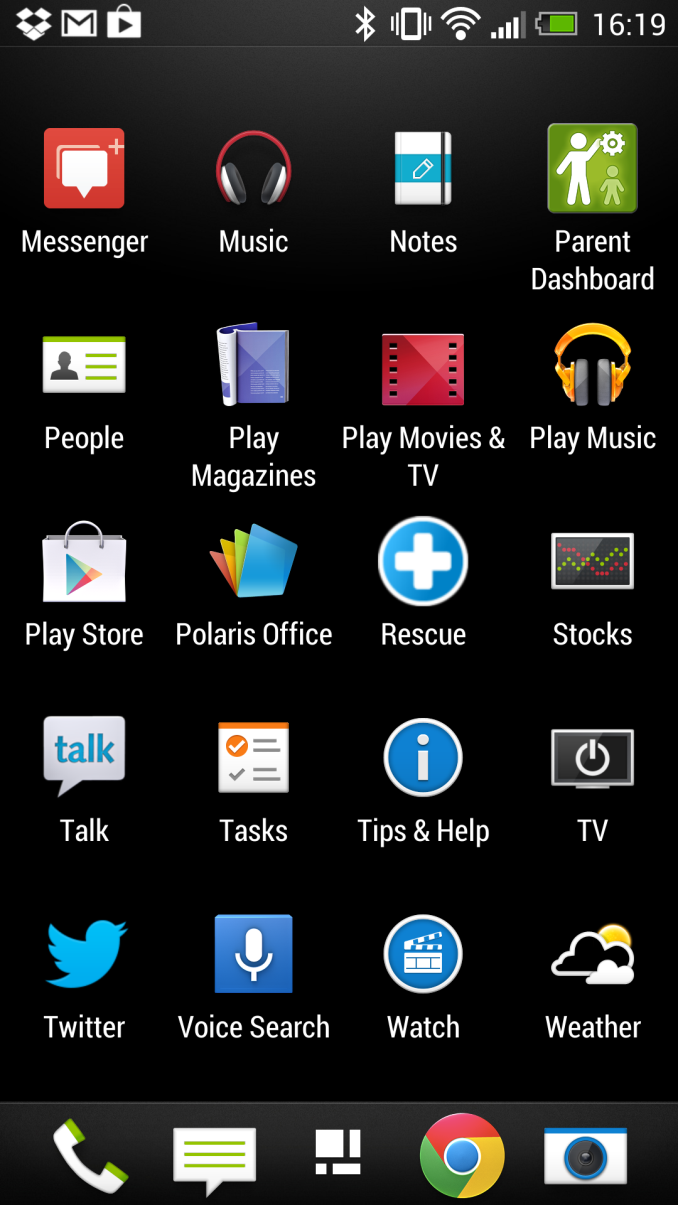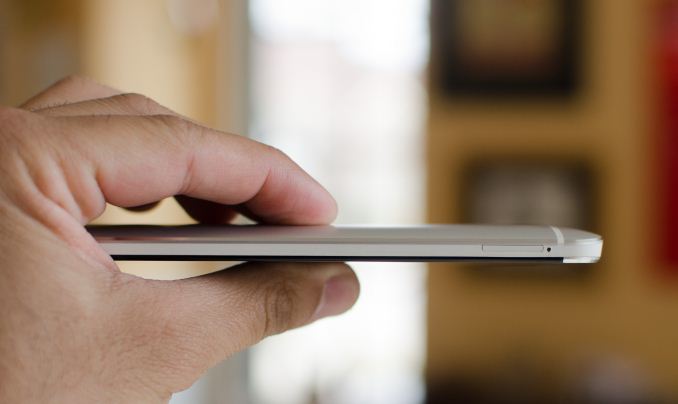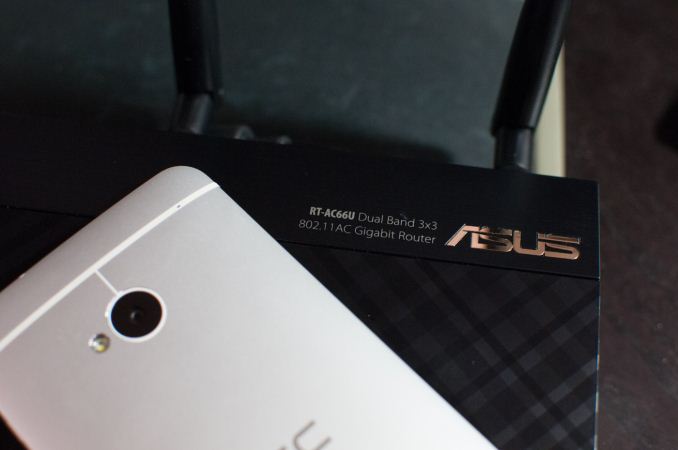The HTC One: A Remarkable Device, Anand’s mini Review
by Anand Lal Shimpi on March 21, 2013 4:49 PM EST- Posted in
- Smartphones
- HTC
- Mobile
- HTC One
Android/Sense
The One ships with Sense 5.0, and I have to say that the latest version of Sense is really the first custom Android skin that I don’t mind. I’m not sold on Blinkfeed, the default homescreen that allows you to aggregate content from multiple web sources as well as Twitter and Facebook, but thankfully you can easily change that default to something more traditionally Android.
With Sense 5.0 HTC dramatically reduced the presence of widgets on the default home screen. Other than the Blinkfeed screen, there’s only a single home screen by default and the only widget on that screen is a Google search box. You can obviously add all of the widgets you want, but this is a noticeable departure from HTC’s strategy in the past. To be honest, it’s a lot cleaner.
Sense 5.0 isn’t intrusive, and the work HTC has done in the gallery app sort of make the customizations worth it (more on this later). Even the default pre-load of apps is very sensible.
Thanks to the underlying use of Android 4.1.2 combined with the fast Snapdragon 600 SoC, UI frame rate is incredibly smooth. Some interactions are still not perfect (e.g. zooming in Google Maps) but the overall experience is very polished and very fast.
Performance & Battery Life
The One is the first Snapdragon 600 based smartphone that I’ve used regularly. For those who aren’t familiar with Qualcomm’s latest branding change, Snapdragon 600 refers to a quad-core Krait 300 based SoC with Adreno 320 graphics (APQ8064T). The SoC still uses the same 28nm LP process as the previous quad-core flagship (APQ8064), but clocks are a bit higher (1.7GHz in the One, 1.9GHz in the Galaxy S 4).
GPU clocks appear unchanged, which is contrary to what I was told at the launch of Krait 300 but it’s entirely possible that we’ll see implementation with higher GPU clocks.
Performance, as I mentioned before, is very good. Even the speed of the NAND HTC used in the device is among the best I’ve seen in Android devices. We’re still not yet at the point where I believe smartphone SoC performance is good enough, but at least we won’t see a huge jump in SoC performance (at similar power) until the move to 20nm in mid to late 2014.
The impact of all of this on battery life, as always, depends on your usage model. I’ve been using the international One on AT&T, and 3G battery life is comparable to the iPhone 5 on the same network (non-LTE) at identical brightness levels. I have yet to see what the difference will be like with LTE enabled.
Obviously with four cores and a larger, higher resolution display, the One definitely has the ability to draw more power than the iPhone 5. Keep the cores more active and/or drive the display at very high brightness levels and you’ll see worse battery life. For the past couple of years I’ve been talking about the increase in dynamic range when it comes to smartphone battery life, the One is no different in this regard. Brian will have a full rundown of battery life data on the One in his review.
Other Frills: Of Big Screens and Usability
For me, the iPhone 5’s display is a little too small, and the One is probably a little too big. I think I agree with Brian here in that the ideal display size is somewhere around 4.3”. That being said, I find both devices (the 5 and the One) to be comfortably usable. The 5 is better for one handed use, while the One is better for actually consuming web content. In pocket, the One is thin enough to not be a problem.
Although it’s probably a bit overkill, I am pleased with the move to 1080p across all of the high end Android smartphones. The One’s display looks excellent and lacks the oversaturated colors of the alternative AMOLED displays.
The One also features stereo speakers that get impressively loud (louder than any other smartphone I’ve used, by a considerable margin). I keep my phone on silent all the time but when showing others highlights reels, the One’s loud stereo speakers definitely come in handy.
The final element of the One that I’m really happy about is the integration of 802.11ac support. The One is good for WiFi speeds of up to 275Mbps (that’s actually tested, not theoretical).














434 Comments
View All Comments
CeriseCogburn - Monday, March 25, 2013 - link
Class 4 is fast enough actually. Just jayspew doesn't really know anything.eebrah - Saturday, March 23, 2013 - link
Why trust that " $COMPANY are not Apple, they probably won't do $BAD_THING " when you can guarantee that they won't fuck you over by getting some features out of the box? say expandable storage and removable battery?phillyry - Sunday, March 24, 2013 - link
Pylon757+1
jayseeks - Friday, March 22, 2013 - link
I've never met anyone who actually purchased one of those battery packs on their own. 9 out of 10 people with those battery packs likely purchased it on a company account.CeriseCogburn - Monday, March 25, 2013 - link
You don't know anyone basement dweller, or anything. Pure trollboy.SirSuperman - Thursday, March 21, 2013 - link
A USB battery pack, which usually requires you to carry a cable around and attach it to your phone and then use your phone with something hanging off it while charging is easier than simply slipping in a battery and instantly returning to a full charge?Pylon757 - Thursday, March 21, 2013 - link
You forgot the part about having to turn the phone off and on.acky2lum - Friday, March 22, 2013 - link
I still don't get why ppl can't get off the grid for that 30 seconds or less. Are you saying your usb battery pack can instantly charge your battery to a full charge within that 30 seconds?Johnmcl7 - Thursday, March 21, 2013 - link
"When I had phones with removable batteries, the only time I ever removed them was to do a hard reset of the phone. Most people don't want to carry around extra batteries, and even if they do, a USB battery pack is easier to carry around than a bare battery."I find USB battery packs a fiddle to use as they're usually a lot larger than a bare battery and they need to remain connected to the phone for quite some time. I take a spare battery when I'm away travelling as it takes a matter of seconds to swap the battery over when the original one dies and then I have a fully functional phone again without having to leave it connected to anything.
Also the other reason I prefer a removable battery is that li-ion batteries don't last forever, they're unlikely to last the two years I expect a phone to last without losing performance if not outright failing and given the reasonably poor batterylife of these devices in the first place that's a prominent issue. Neither my N900 or Galaxy Note's original batteries lasted two years but it wasn't an issue as a couple of minutes later they were up and running with another battery.
"Most people also don't carry around spare memory cards, either. I can understand why someone might be worried about not being able to add additional storage space to a phone that only comes with 8 or even 16GB of storage, but do you really expect the average user to run out of space in a phone that comes with up to 64GB of flash? My desktop PC has only a 64GB SSD right now! Especially in the age of streaming media, memory cards are increasingly unnecessary in smartphones."
With increasingly powerful phones, higher resolution onboard video and increasingly higher resolutions, I disagree - why put up with lower quality video and reduced selection rather than have the option of being able to cheaply add storage. The Note's large vibrant screen is great for watching and showing videos, yes I could delete off the 1080p video files from its own camera and have a much smaller selection of videos but for the small cost of a microSD card I prefer to keep them onboard and take advantage of the screen Plus the price companies charge for storage is usually vastly more than it would cost as a microSD card, the cost difference between a Nexus 8GB and a 16GB over here would be enough to purchase a 64GB micro SD card. It also means the phone can take advantage of increasing flash capacities over its life.
As for streaming as a viable alternative, I also disagree for quite a few reasons. Firstly it may not even be possible either due to reception not being good enough, not allowed to have wireless radios enabled or congestion in the area, secondly data caps are frequently restrictive and third the phone needs a lot more power to stream wirelessly compared to just reading it off internal memory.
Plus there no gains from not having a removable battery or expandable storage with the HTC (aside from for HTC themselves), despite the praise in this article I don't count the metal body as a plus because if it's anything like previous HTC phones and most other metal phones on the market the metal is unlikely to be particularly durable and will easily pick up scratches and chips. There's a lot of complaining about Samsung using plastics but they're light and they're durable, I've seen some original S2's that have been used without a case and dropped a few times yet they've barely a mark on them whereas Sensations from the same time period were looking fairly battered in the same conditions after a few weeks despite the praise for the Sensation's supposed industrial build quality and the cheap build quality of the S2.
John
CeriseCogburn - Friday, March 22, 2013 - link
The apple tards suddenly have no media - no music, no movies, no videos, no minutes and minutes of high resolution camera movies - the appletards don't like storage space, they yell at Siri to dial then they pocket their lead weight glass shatterbrick.I guess it was all true - apple users are inherently STUPID...